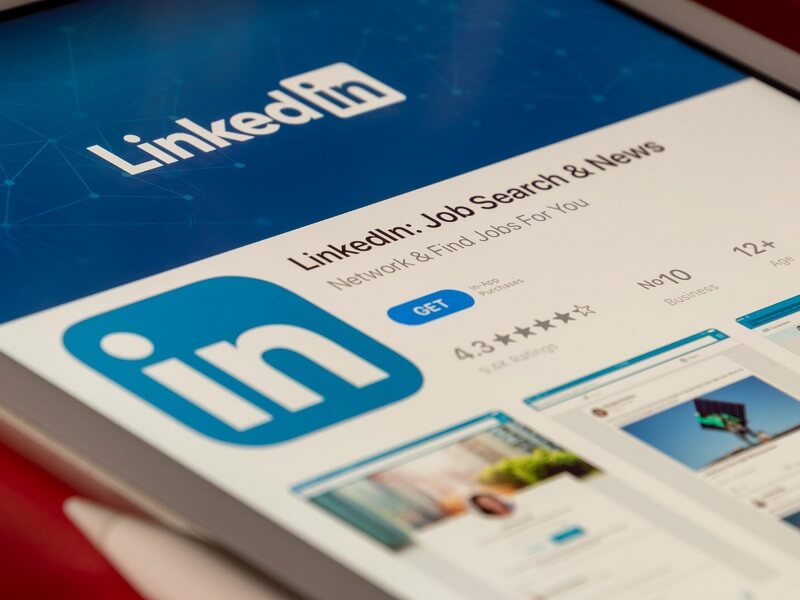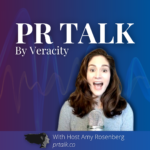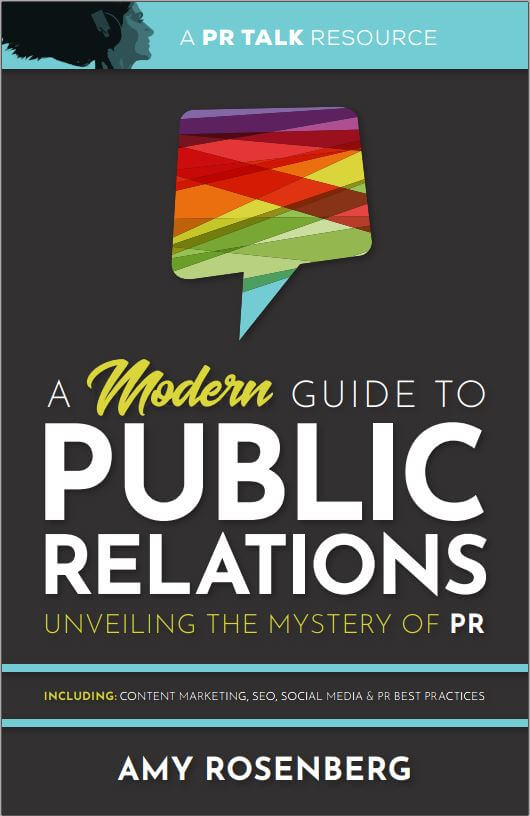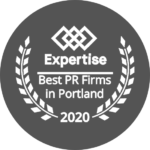Today’s competitive climate in the age of social media has made one thing clear: Marketing a business as an entity is only part of the equation. When presented with endless options, consumers are increasingly choosing to work with companies that show a face behind the brand. More than just the CEO, industry leaders are using their platforms to simultaneously represent the organization online while also building their own professional brands.
At first, the task of distinguishing ourselves from the millions of other experts in our fields will undoubtedly seem arduous. That said, thought leadership is one of the most effective and genuine ways to do so.
Thought leadership runs deeper than knowledge on a subject or industry. Being a thought leader — a true expert in your field — means positioning yourself as the resource people go to first when seeking information.
Where does that start? Within your business network.
Where does that network live? LinkedIn.
With more than 774 million members and its focus on business, LinkedIn offers a valuable opportunity for industry professionals to establish themselves as thought leaders and support business marketing goals in the process.
They say it all in their mission statement: “Connect the world’s professionals to make them more productive and successful.” LinkedIn’s premise is to share, connect, and interact with your business and expertise at the forefront of the conversation. All of which are essential to any successful thought leadership campaign.
Critical Elements to a Thought Leader’s LinkedIn
As with any social media platform, there are ways to maximize LinkedIn’s effectiveness using a thought leadership strategy.
Optimized Profile
Gone are the days when your LinkedIn profile was essentially just a dry online resume. Now we must treat our profiles as a personal landing page. Yes, listing our experience and education are still crucial components, but we must also prioritize eye-catching headlines, powerfully written information, and the use of visual elements.
Headshot and Cover Photo: Put your best face forward! Use a professional headshot (or as close to professional as possible) for your profile photo. Be sure also to add a high-res cover photo that best represents your work or company. Recommended dimensions are a 400px x 400px headshot, and a 1128px x 191px cover photo. LinkedIn accepts JPG, GIF, and PNG uploads.
Headline: Your headline is situated right below your name on your LinkedIn profile, and it’s more than just a job title. It’s your 220-character billboard advertisement to your target audience. Describe your expertise clearly and how you benefit your company or customers. Additionally, use keywords where you would want to appear in a search. Let’s use the profile of one of our recent podcast guests, Roshanda Pratt, as an example:
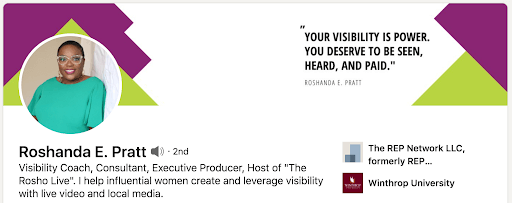
In just 164 characters, Roshanda shares what she does and who she helps with her target audience in mind, all while utilizing appropriate keywords such as “Visibility Coach” and “live video.” Note: While writing this article, I tested these keywords by searching “Live Video Coach.” Roshanda’s profile was at the top of my search results (Shown below).

Featured Section: This section allows you to showcase select posts and add links to external websites, images, or documents. As a thought leader, it’s an excellent opportunity to highlight the meaningful work you’re doing at your company, key media appearances, and published work you’ve authored.
It is toward the top of your profile between the About Section and the Activity Section. If you do not see this feature, don’t worry! LinkedIn is still gradually rolling it out to all members.
About Section: With 2,000 characters available, this is where you can expand on what you wrote in your headline. Tell your story as it relates to the mission of your company. The About section is also your opportunity to strengthen your profile further by painting a picture of who you are as a professional and your unique perspective as a thought leader. Like the headline, keywords are also crucial here, so be sure to include any terms you want to appear in search results.
Experience and Education: Ensure this section is detailed and up-to-date, especially your position at your current company. Offering a description of your current role spotlights the organization and your purpose-driven work.
Consistent, High-Quality Content
Establishing your presence as a thought leader on LinkedIn doesn’t happen overnight, but organic growth is possible — I would even say inevitable — when you consistently share relevant, engaging content.
Now this comes with a bit of a caveat: Not all content is created equal. In Edelman’s 2021 B2B Thought Leadership Impact Study, 71% of decision-makers said that less than half of the thought leadership they consume gives them valuable insight. The popularity of thought leadership has skyrocketed, but the mysticism around the buzzword has propelled people into simply regurgitating standard lines and mantras to serve their brand.
On the other hand, authentic thought leadership comes from an internal motivation to provide value to others. Take time to access a broader view of your industry, consider the meaning of current trends, and start conversations through your posts. To lead in this way, you must share content that offers your original perspective and new ways of looking at common problems or challenges in your field.
Examples of Content to Share:
- Share blog articles, thought pieces, essays, and case studies you’ve authored.
- Promote upcoming webinars and live presentations in which you’re participating. Once the conference is over, you can repurpose the content by sharing video snippets, photos, and key takeaways.
- Highlight media interviews and appearances.
- Post relevant videos, photos, and long-form text posts.
- Share related news, articles, and other user-generated content with your added perspective in the post.
Putting yourself out there also takes courage. For that reason, here are some helpful questions to ask yourself and get inspired:
Does this have the potential to help someone?
Why aren’t more people talking about this piece of news?
Could this spark an interesting discussion?
Am I authentic in the content I’m sharing?
Posting Schedule: Consistent posting on LinkedIn is critical to establishing a thought leadership presence, so here are some tips to keep you on track:
- Post 3-5 times per week, 1-2 times per day.
- HubSpot found that posts perform best Tuesday through Thursday between 8 AM and 2 PM, depending on your time zone.
- With that in mind, also think about when you’re available to log into LinkedIn. The days you’re able to comment and engage in real-time must be prioritized.
- Lastly, a posting schedule is only as valuable as the content you share, so when in doubt, quality over quantity.
Meaningful Engagement
When using LinkedIn to build your position as a thought leader, engagement is critical. The likes, comments, and re-shares all put you in someone new’s line of vision. Sure, a piece of high-quality content may be engaging enough on its own. But, a successful long-term thought leadership campaign requires strategically positioning your content in front of the right people and taking time to engage actively.
Know Your Audience: Become familiar with who is reading your content and who might seek you out as an information resource. Doing so will give you better insight into your followers and help you target your content topics accordingly.
Actively Engage: In addition to understanding your audience for better engagement, you must also actively engage with them. For instance, try mentioning your connections where appropriate in the post or comment section so they can join the discussion.
Note: If you are using a social media scheduling tool like Hootsuite, mentioning a person’s profile in a post is not an available feature. To tag someone’s LinkedIn profile, you’ll need to post directly on the platform or edit the post on LinkedIn once published by the scheduling tool.
Additionally, spend some time liking and commenting on others’ posts. It not only strengthens interactions with your connections but sets you in front of all of their connections as well. Because of LinkedIn’s business-oriented platform, your engagement will nurture existing business relationships and certainly build new ones.
Bonus Points: Utilizing Native Tools
As with any social media platform, LinkedIn wants you to utilize the native tools they offer, like their LinkedIn Publishing or LinkedIn Live. When you do, the algorithm will reward you with higher reach and more impressions. For example, if you regularly write blog posts and share the link, try writing a LinkedIn Publishing article instead every so often. You may notice an increase in engagement.
Appreciate The Long Game
Effective thought leadership boosts your marketing efforts and company’s reputation, with 63% of buyers saying that thought leadership “is important in providing proof that an organization genuinely understands or can solve your specific business challenges” (Edelman, 2021 B2B Thought Leadership Impact Study). The process of becoming a thought leader may take time, but with patience, consistency, and thoughtful strategy, establishing yourself as a respected industry expert on LinkedIn is achievable.

